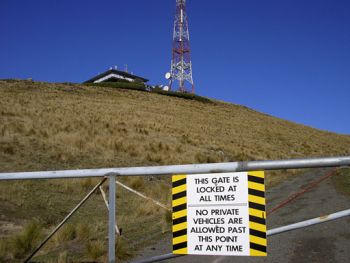Site Access: Difference between revisions
No edit summary |
No edit summary |
||
| (4 intermediate revisions by 3 users not shown) | |||
| Line 1: | Line 1: | ||
__NOTOC__ | __NOTOC__ | ||
[[Category: | [[Category:Operation and Maintenance]] | ||
---- | ---- | ||
<!-- | {{Picture | ||
[ | <!-- Add image file name (ex.image.jpg) --> | ||
|image= RestrictedAccess.jpg | |||
<!--Add link if applicable --> | |||
|link= | |||
<!-- Add picture caption --> | |||
|caption= To protect sites and individuals, signage, gates, and other safety measures are employed. | |||
(Image Source: [https://commons.wikimedia.org/wiki/File:Sugarloaf_RestrictedAccess.jpg Wikimedia]) | |||
}} | |||
== | "[[Site Security|Project security]] is a matter of concern at all major dams. This includes preventing [[structural]] damage by vandals or saboteurs and unauthorized [[operation]] of outlet or spillway gates. In most cases, restricting public access is essential, and in some instances armed guards may be necessary."<ref name="FEMA P93">[[Federal Guidelines for Dam Safety (FEMA P-93) | Federal Guidelines for Dam Safety (FEMA P-93), FEMA, 2004]]</ref> | ||
==Best Practices Resources== | "[[Public Safety|Public safety]] is of paramount importance at all dams and [[reservoirs]]. Specifically, [[Public Safety|public safety]] on the reservoir, in areas adjacent to the reservoir, and below the dam should be considered, particularly in recreational areas. Safety measures should include identification of high watermarks to indicate past or probable reservoir levels and [[streamflows]], posting of safety instructions at highly visible and key locations, and providing audible safety warnings upstream of and below outlets as appropriate."<ref name="FEMA P93" /> | ||
{{Document Icon}} | |||
Furthermore, site access must be maintained for proper operation, maintenance and emergency intervention and response. Access to the dam and its appurtenances during floods and other unusual events should be taken into consideration by the dam [[owner]]. | |||
<noautolinks>==Best Practices Resources==</noautolinks> | |||
{{Document Icon}} [[Federal Guidelines for Dam Safety (FEMA P-93) | Federal Guidelines for Dam Safety (FEMA P-93), FEMA]] | |||
<!-- For information on notation for in text citations visit https://www.mediawiki.org/wiki/Help:Cite Or simply enclose the citation as shown <ref> citation </ref> in the location of the in text mention. Citations will automatically populate below--> | <!-- For information on notation for in text citations visit https://www.mediawiki.org/wiki/Help:Cite Or simply enclose the citation as shown <ref> citation </ref> in the location of the in text mention. Citations will automatically populate below--> | ||
Latest revision as of 17:44, 19 July 2023

|
| To protect sites and individuals, signage, gates, and other safety measures are employed.
(Image Source: Wikimedia) |
"Project security is a matter of concern at all major dams. This includes preventing structural damage by vandals or saboteurs and unauthorized operation of outlet or spillway gates. In most cases, restricting public access is essential, and in some instances armed guards may be necessary."[1]
"Public safety is of paramount importance at all dams and reservoirs. Specifically, public safety on the reservoir, in areas adjacent to the reservoir, and below the dam should be considered, particularly in recreational areas. Safety measures should include identification of high watermarks to indicate past or probable reservoir levels and streamflows, posting of safety instructions at highly visible and key locations, and providing audible safety warnings upstream of and below outlets as appropriate."[1]
Furthermore, site access must be maintained for proper operation, maintenance and emergency intervention and response. Access to the dam and its appurtenances during floods and other unusual events should be taken into consideration by the dam owner.
Best Practices Resources
![]() Federal Guidelines for Dam Safety (FEMA P-93), FEMA
Federal Guidelines for Dam Safety (FEMA P-93), FEMA
Citations:
Revision ID: 7327
Revision Date: 07/19/2023
